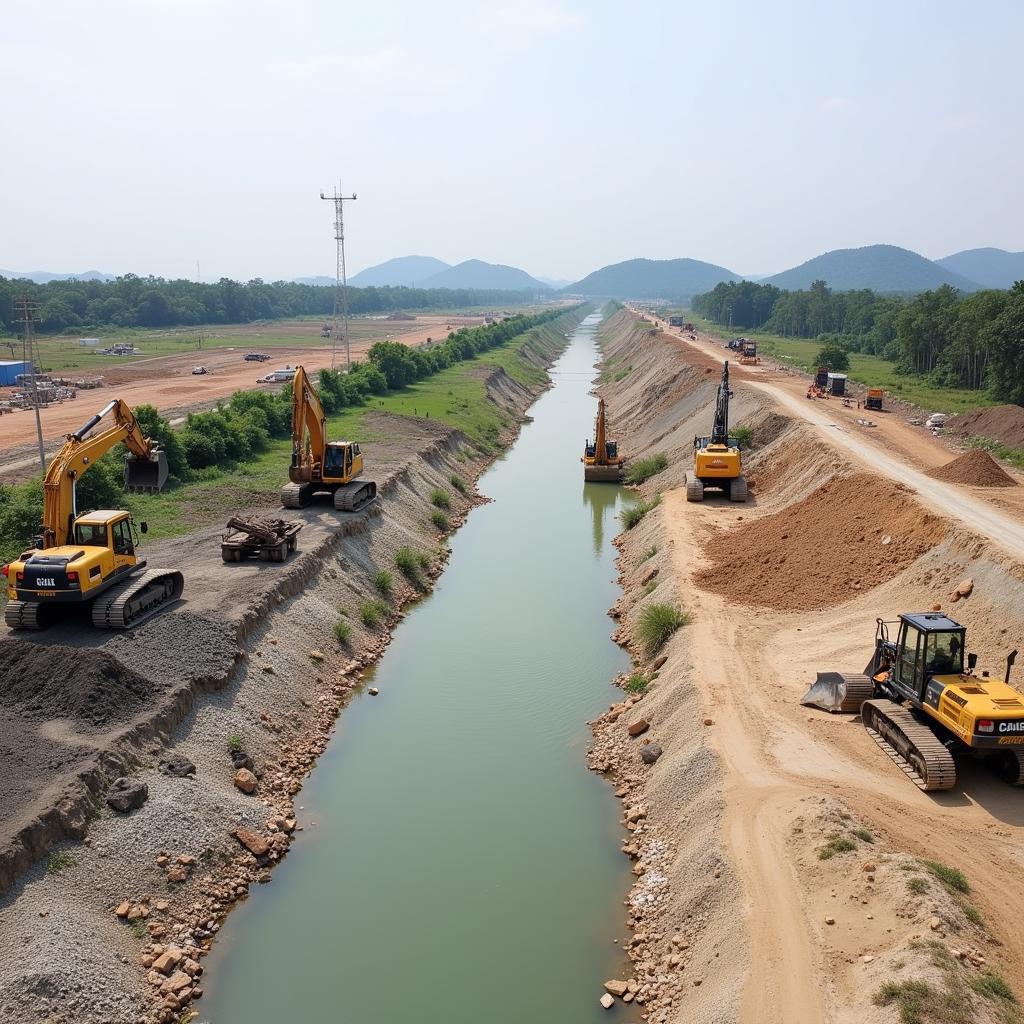Dredging and Embankment Construction in Cau Ngang Canal, Thu Duc
January 6, 2025Dredging and embankment construction projects are crucial for maintaining and improving the Cau Ngang canal in Thu Duc. These processes ensure efficient water flow, prevent flooding, and contribute to the overall development of the surrounding area. This article will delve into the importance of dredging and embankment construction in Cau Ngang Canal, Thu Duc, highlighting the benefits, processes, and considerations.
The Importance of Dredging and Embankment Construction in Cau Ngang Canal
Cau Ngang Canal plays a vital role in Thu Duc’s infrastructure, serving as a drainage system, transportation route, and even a source of irrigation for some areas. Over time, sediment, debris, and vegetation accumulate in the canal, restricting water flow and increasing the risk of flooding. Dredging, the process of removing this build-up, is essential to maintain the canal’s functionality. Furthermore, reinforcing the canal banks with embankments helps prevent erosion, protects surrounding properties, and enhances the canal’s overall stability.
Benefits of Dredging
- Improved Water Flow: Dredging removes obstructions, allowing water to flow freely, reducing flood risks and improving drainage efficiency.
- Enhanced Navigation: A clear canal facilitates smoother and safer navigation for boats and other watercraft.
- Environmental Benefits: Removing contaminated sediment can improve water quality and support a healthier aquatic ecosystem.
- Increased Canal Capacity: Dredging increases the canal’s capacity to hold water, further mitigating flood risks.
Benefits of Embankment Construction
- Erosion Control: Embankments stabilize the canal banks, preventing erosion caused by water flow and weather conditions.
- Flood Protection: Reinforced banks provide better protection against flooding by containing the water within the canal.
- Land Reclamation: Embankment construction can create additional land alongside the canal, which can be utilized for various purposes.
- Infrastructure Support: Stable embankments provide a solid foundation for roads, bridges, and other infrastructure projects along the canal.
The Process of Dredging and Embankment Construction
Dredging and embankment construction involve a series of carefully planned and executed steps:
- Site Assessment: Experts assess the canal’s condition, identifying areas requiring dredging and embankment reinforcement.
- Planning and Design: Engineers develop detailed plans for the dredging and embankment construction, considering environmental impact and project requirements.
- Dredging Operations: Specialized equipment, such as excavators and dredgers, are used to remove sediment and debris from the canal bed.
- Embankment Construction: Soil, rock, and other materials are used to build and reinforce the canal banks.
- Monitoring and Maintenance: Regular monitoring and maintenance are crucial to ensure the long-term effectiveness of the project.
 Embankment construction along Cau Ngang Canal
Embankment construction along Cau Ngang Canal
Key Considerations for Dredging and Embankment Construction in Cau Ngang Canal
Several crucial factors must be considered when undertaking dredging and embankment construction projects in Cau Ngang Canal:
- Environmental Impact: Minimizing the environmental impact of these projects is paramount. Proper disposal of dredged material and careful construction practices are essential.
- Community Engagement: Engaging with local communities and addressing their concerns is vital for project success.
- Cost-Effectiveness: Balancing project costs with long-term benefits is essential for sustainable development.
- Regulatory Compliance: Adhering to all relevant regulations and obtaining necessary permits are crucial for legal and responsible project execution.
“Effective dredging and embankment construction are investments in the future of Thu Duc, ensuring the long-term health and functionality of Cau Ngang Canal,” says Dr. Nguyen Van Anh, a leading expert in water resource management. “These projects contribute not only to flood mitigation but also to economic development and environmental sustainability.”
Conclusion
Dredging and embankment construction in Cau Ngang Canal, Thu Duc, are essential for maintaining the canal’s functionality, mitigating flood risks, and supporting the region’s development. By carefully considering environmental impacts, community needs, and project costs, these projects can contribute to a more sustainable and resilient future for Thu Duc.
FAQ
- How often should Cau Ngang Canal be dredged?
- What materials are used for embankment construction?
- What are the environmental regulations related to dredging?
- How does dredging improve water quality?
- What is the typical lifespan of an embankment?
- How can the community participate in the project planning process?
- What are the alternative solutions to dredging?
Common Scenarios and Questions
-
Scenario: Increased flooding in the area surrounding Cau Ngang Canal.
-
Question: How can dredging and embankment construction address this issue?
-
Scenario: Erosion of the canal banks is threatening nearby properties.
-
Question: What type of embankment construction is most effective in preventing further erosion?
-
Scenario: Local residents are concerned about the environmental impact of dredging.
-
Question: How can the project mitigate these environmental concerns?
Further Information
For more information on dredging and embankment construction projects, please explore our other articles on:
- Sustainable Dredging Practices
- The Importance of Canal Maintenance
- Flood Mitigation Strategies
If you need assistance, please contact us at Phone Number: 0396443476, Email: [email protected] or visit our address: 23 Thang 3, Dak Nia, Gia Nghia, Dak Nong, Vietnam. We have a 24/7 customer service team.